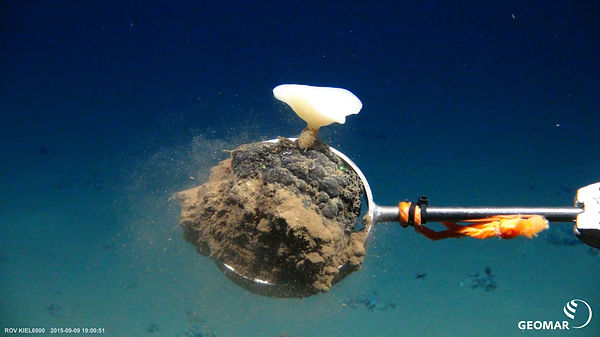

The Rov deep research vehicle in a field of hydrothermal vents discovered in 2016 at Chamorro Seamount. Photo: NOAA - The National Oceanic and Atmospheric Administration
In the deep, dark depths of the ocean, a majestically tentacled creature drifts weightlessly above a bed of polymetallic nodules. The outlandish Atolla wyvillei, known as the "alarm jellyfish," spreads its deep red tendrils across this terraqueous realm, a guardian of this plain of lucrative minerals. When startled, it emits pulses of bioluminescent blue light into the abyss—a dazzling warning system honed by evolution. Over millennia, marine life has developed an astonishing array of ingenious forms, functions, and survival strategies. The Atolla wyvillei, with its illuminated bulbous crown, stands as a sublime overseer of the deep. Yet, even this remarkable sentinel could not have foreseen the plundering of its habitat.

A black smoker known as "the brothers", a hydrothermal vent in the seabed that emits mainly sulphurous minerals. Photo: NOAA - The National Oceanic and Atmospheric Administration
While the Atolla effortlessly navigates its watery kingdom, we explore this hidden, inaccessible world through remotely operated robots. These machines traverse the depths, gathering data on subsea structures and geological formations, such as hydrothermal vents.
Volcanic tremors and eruptions on land are extensively monitored, yet the surveillance of ocean volcanism remains in its infancy. Beneath immense heat and pressure, frequent eruptive and tectonic events sculpt vibrant geothermal landscapes. The deep-sea geomorphology is theatrical, marked by mammoth canyons, jagged ridges, towering hydrothermal plumes, and abundant seamounts. Deep-marine volcanism drives Earth’s most energetic exchanges of heat and mass between the crust and the oceans.
Through the eye of a lens, we explore this alien world—collecting specimens with robotic arms and observing through screens. A realm where humans remain estranged and may never set foot is unveiled through advanced engineering, yet more than 80% remains unexplored.

White smoke in the Champagne vent field, a spring that emits light-coloured minerals containing barium, calcium and sulphur. Photo: NOAA - The National Oceanic and Atmospheric Administration
Man’s underwater eye has given us a glimpse into the mysteries of the self-regulation of ocean chemistry. Chromatic geologic crusts of varying size are sculpted from ejections of hot sulphuric liquid plumes and molten lava excretions. As the vent minerals cool and solidify, the floor draws in seawater, rearranges the water's chemical composition, and spews out transformed fluids. Like a cell membrane, the seafloor acts as a selective barrier, extracting specific metals while releasing others. These vents and plumes function as chemical reactors, and play a vital role as guardians of the oceans ecosystem, helping to maintain the equilibrium of ocean chemistry.
This once-pristine and fiercely unique part of the world shimmers with now-profitable nodules. Formed over millions of years yet extracted in mere hours. The greatest obstacle to coexistence is the relentless drive to strip the seafloor without foresight, risking the loss of entire, undiscovered ecosystems.

A manganese nodule. Photographed as part of a GEOMAR study - Helmholtz Center for Ocean Research in Kiel, Germany. Photo: ROV Team/GEOMAR (CC-BY 4.0)
Many of these elements found at hydrothermal sites are considered to be crucial for more powerful and advanced technological applications although countless microbiologists believe the unusual physical and chemical conditions of hydrothermal systems may have provided the environment for the origins of life on Earth. Instead of pertaining to the role of voyeuristic guardian or observer, if we accelerate into extraction of these lucrative systems, we could jeopardise the potential to learn more about the complex evolutionary microbial synergies.

Raw materials from the exhibition The Secrets of Matter - Photography: Uri Shifrin
If we were to engage with these sublimely sophisticated geological entities and respect their life force from a pluralistic perspective—not solely valuing them for extraction—we might come to appreciate and cherish the complex biological interactions they sustain. Already, these interactions have led to beneficial applications, such as the development of novel antibiotics, advancements in waste remediation, and breakthroughs in biofuels.
The more we understand about the inner workings of these undersea territories, the more we might expect to forge empathetic and ethical ways of working in these depths. Rather than knowledge leading to conservation, understanding our power over the earth's resources hasn't resulted in protection but is instead being harnessed for maximum profit.
A tectonic shift is underway in mining. The seafloor holds the largest concentration of metals on Earth, including rare earth elements and those 'critical' for battery technologies, such as nickel, cobalt, and zinc. Despite calls for a global moratorium on deep-sea mining, The Metals Company (TMC, formerly Deep Green) extracted 3,000 tonnes of nodules from the Pacific Ocean in November 2022. Through its slick and persuasive website, TMC surreptitiously greenwashes its operations, framing the billion-dollar electric vehicle industry as a climate savior.

An arm of the research vehicle ROV KIEL 6000 grasps a manganese accumulation on the sea floor. Photographed as part of a GEOMAR study - Helmholtz Center for Ocean Research in Kiel, Germany. Photo: GEOMAR (CC-BY 4.0)
By abusing the rhetoric of ‘urgent action on climate change’, TMC has secured agreements with small island nations, pushing through contracts driven by profit. This short-sighted and risky venture hinges on the volatile monetary value of metals, which can fluctuate or collapse, potentially leaving these nations in substantial debt.
Amid rising geopolitical tensions—marked by full-scale war (Ukraine-Russia) and escalating U.S.-China frictions—the global market remains as unpredictable as the ocean floor itself. The deep sea is violent, unruly, and fragile. Its brutal and experimental upheaval for resource extraction could have catastrophic consequences.
Mining has always posed both societal and ecological risks. The devastation of terrestrial mining is starkly visible from Google Earth's satellite imagery—black craters scarring the terrain, glitches upon our screens. But beneath the ocean’s surface, destruction is easily concealed, making its consequences even more insidious.
Ocean floor upheaval produces sediment plumes that rise for 100’s of metres, suffocating inhabitants, and destroying life forms upon encounter. The seabed nodules and crusts are a great storage holder of CO2 and the consequences and long lasting effects of unearthing rock from the seafloor are unknown. Humans have intercepted to become geological agents, creating changes amongst important and protective physical processes of the earth.

Nested in dimensions that form the groundless ground - Charly Blackburn, 2022 - Photographic print
Anthropogenic disturbance is accelerating faster than scientific discovery.
Once the ocean’s metallic rocks break the water’s surface and are subsequently labelled, quantified, and commodified, the magic and wonder of their native habitat dissolves. Stripped of their origin, the minerals are processed into unrecognisable powders, with many transforming into oxides and alloys that are engineered and reconfigured.
The assumption that processed materials are inert, static, stable, homogeneous, or unreactive overlooks their vital role in the biosphere from which they were extracted. Their inherent potential is severed from its source, and in the process, an innate vibrancy is lost.
Mined to serve a set of predefined functions, white powder after white powder, the hyper-abstraction of ores makes it difficult to recognise these resources as having an inherent life force, diminishing the sensory aesthetic connection we might have once had. Deep-sea nodules and crusts are processed into their 'purest' elemental forms and industrially bonded compounds, engineered to perform a dizzying array of functions. In a bleak supply chain of unaccountability, these engineered materials will outlast humans by a long shot. What if we began to view these harvested nodules as living entities, possessing knowledge and intelligence—as agents rather than mere objects?

Industry often looks at the mechanical physicality of materials, properties like strength, ductility or hardness in order to perform specific functionalities to a high order of quality control. However, when materials undergo large-scale industrial mechanical and chemical processing, their sensory qualities are often extinguished. Through this abstraction, crucial material information becomes either redundant or completely lost.
Ancient metalworkers were once seen as possessing special rites, and laborers were described as quasi-magicians, granted privileges for their ability to transform metal, which was considered supernatural. The ways in which we have mined and exploited metals and oxides are deeply intertwined with technological breakthroughs and the advancement of civilisation itself.
In craft communities, the relationship between maker and material fosters an intimate connection, forged through a dialogue between the hands and the eyes, and encompassing both the emotional and sensual—visual and tactile. If we were to reimagine material futures with new potentials, incorporating the hybridisation of chemistry and craft, how might the sensitive qualities of craft be integrated into material science?
In an information-driven society, quick to dispose of gadgets without understanding their provenance, the dialogue between maker and object—a reciprocal exchange of inherited knowledge and experience—has been profoundly compromised. This is not a new development; arguably, the Industrial Revolution began distancing us from a collective understanding of how physical objects are made. Glenn Adamson describes this as the loss of material intelligence.
If material intelligence is being abandoned by the masses and replaced with 21st-century specialisation, it inevitably leads to a dissonance between the origin and chemical makeup of the materials that shape our world. How, then, can we reclaim and forge new bonds between the raw materials—like those mined from the deep ocean—and the conception of physical objects?

As specialisation rises, the necessary collaboration between coders, engineers, and craftspeople holds the potential to revolutionise the world of material science. The future of materials design could foster deeper and more meaningful connections to both our immediate and remote environments, rather than continuing the trend of abstraction and alienation.
We’re already witnessing these potentials in the emergence of self-healing fabrics, superconductors, and sentient materials—those capable of detecting their state and adapting accordingly. Cultivating compassion for these vibrant, lively entities—whose behaviours are increasingly performative, akin to organisms or creatures—could enhance our ability to connect sensitively with the origins of raw minerals at subsurface depths.
If this holds true, then there is hope for Atolla, safeguarding the deep ocean depths, and for ushering in a (greener?) revolution.



